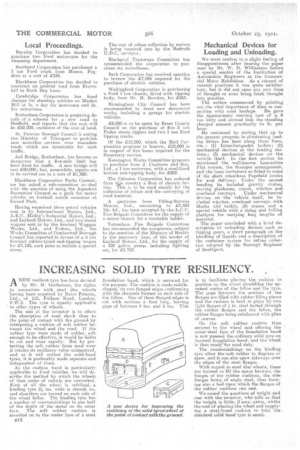INCREASING SOLID TYRE RESILIENCY.
Page 8

If you've noticed an error in this article please click here to report it so we can fix it.
A NEW resilient tyre has been devised Pi by Mr. H. Gocibchere, the rights in connection with steel disc wheels having been acquired by Baico Patents, DAL, of 115, Fulham Road, London, S.W.3. The tyre is equally applicab!e to other types of wheels.
The aim of the inventor is to effect the absorption of road shock close to the point of contact with the. ground by interposing a cushion of soft rubber between the wheel and the road. If the rubber tyre were made of rubber soft enough to be effective, it would be liable to cut and wear rapidly. But by protecting the soft rubber from road wear it retains its resiliency value unimpaired, and as it will outlast the solid-band tyres, it is preferably made separate and independent of them.
As the cushion band is particularly applicable to Fend vehicles, we will describe the method by which the wheels of that make of vehicle are converted. First of all the wheel is refelloed, a binding tyre 2i ins_ wide is shrunk on, and shoulders are turned on each side of the wheel felloe. The binding tyre has a number of countersinkings to one half of the depth of the metal on its outer face. The soft rubber cushion is moulded on to the under face of a steel B12 foundation band, which is serrated for the purpose. The cushion is made saddle. shaped, its two flanged edges conforming with the channels formed on each side of the false. One of these flanged edges is cut with sections a foot long, leaving gaps of between 4 ins. and 5 ins. This is to facilitate placing the cushion in position on the wheel straddling the upraised centre of tins felloe and the tyre. The paps between the sections of the flanges are filled with rubber filling pieces and the cushion is held in place by two light flanges of f in. steel bolted through the rubber flanges and the felloe, the rubber flanges being reinforced with plies of canvas.
On the soft rubber cushion thus secured to the wheel and offering the outer•steel face of the foundation band is now pressed the ordinary solid tyre on its-isteei foundation band, and the wheel is then read' for road duty.
The countersinkings on the binding tyre allow the!soft rubber to displace or spew, and it can also spew sideways over. the edges of the steel flanges.
With regard to steel disc wheels, these are formed to fill the space between the flanges of the rubber cushions, the sick, flanges being of angle steel, thus forming also a bed-upon which the flanges of the rubber cushions can rest.
We raised the questions of weight and gest with the inventor, who tells us that the weight is little, if sany, extra, whilst the cost of altering the wheel and supplying a steel-fircied cushion to take the standard solid band tyre is small.






























